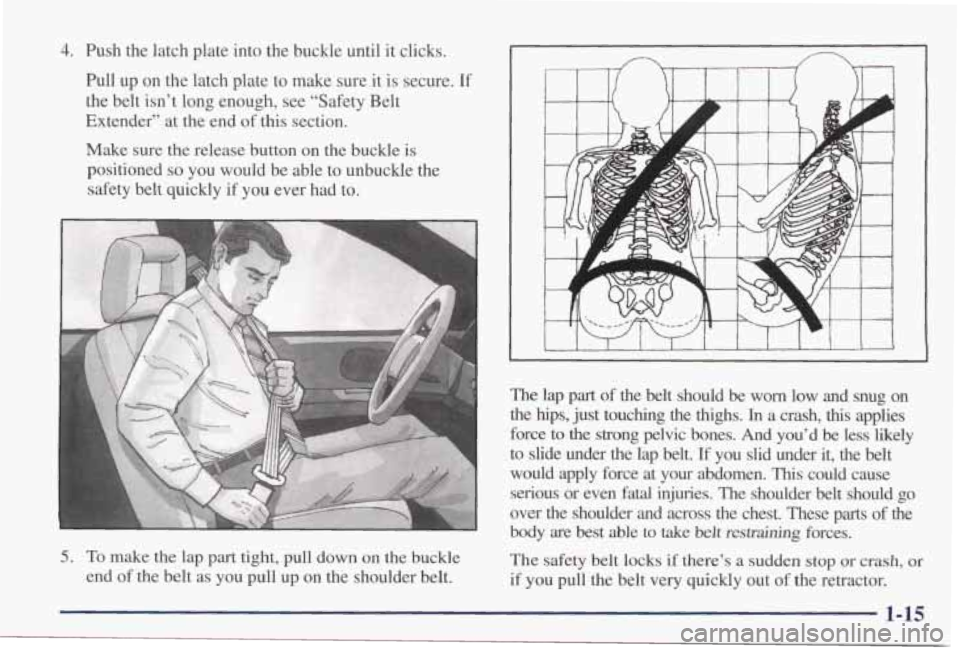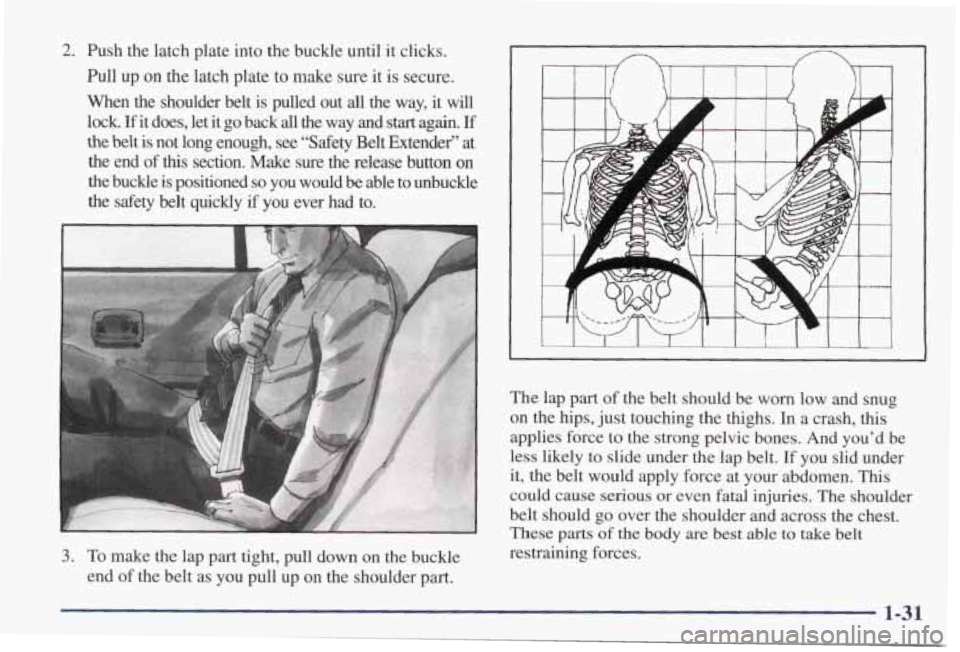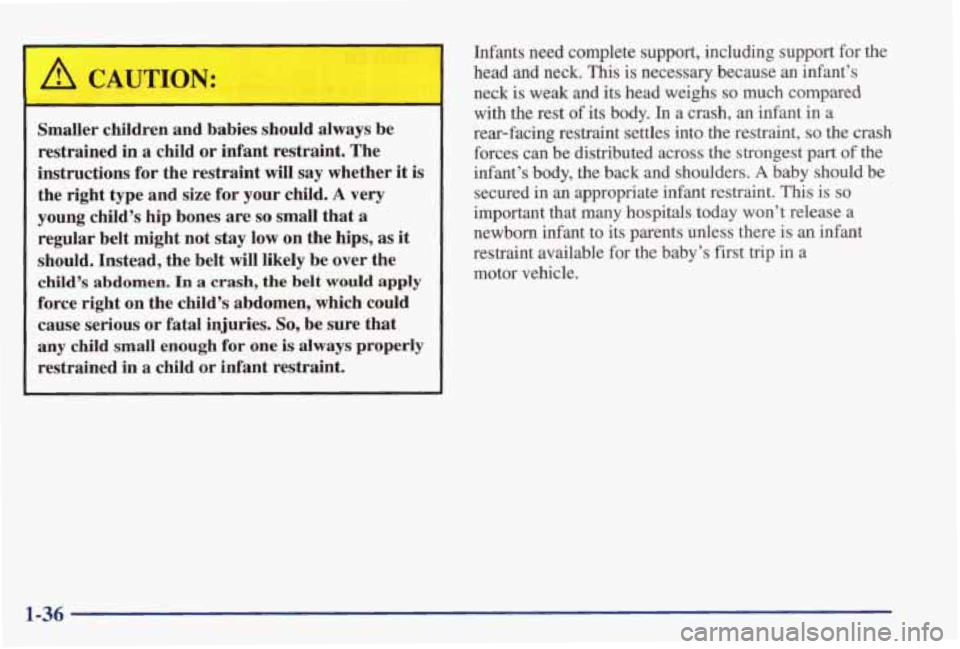Page 22 of 402

4. Push the latch plate into the buckle until it clicks.
hll up on the latch plate
to make sure it is secure. If
the belt isn’t long enough, see “Safety Belt
Extender” at the end of this section.
Make sure the release button on the buckle is positioned
so you would be able to unbuckle the
safety belt quickly if you ever had
to.
The lap part of the belt should be worn low and snug on
the hips, just touching the
thighs. In a crash, this applies
force to the
strong pelvic bones. And you’d be less likely
to slide under the lap belt.
If you slid under it, the belt
would apply force at your abdomen,
This could cause
serious or even fatal injuries. The shoulder belt should go
over the shoulder and across the chest. These parts
of the
body are
best able to take belt resb.aining forces.
5. To make the lap part tight, pull down on the buckle
The safety belt locks if there’s a sudden stop or crash, or
end of the belt as you pull up on the shoulder belt.
if you pull the belt
very quickly out of the retractor.
1-15
Page 30 of 402

A CAUTION:
Air bags inflate with great force, faster than the
blink
of an eye. If you’re too close to an inflating
air bag, it could seriously injure you. This is true
even with reduced-force frontal air bags. Safety
belts help keep you in position before and during
a crash.
Always wear your safety belt, even with
reduced-force air bags. The driver should sit as
far back as possible while still maintaining
control of the vehicle.
/I CAUTION:
Children who are up against, or very close to, an
air bag when it inflates can be seriously injured
or killed. This is true even though your vehicle
has reduced-force frontal
air bags. Air bags plus
lap-shoulder belts offer the best protection for
adults, but not for young children and infants.
CAUTION: (Continued)
CAUTION: (Continued)
Neither the vehicle’s safety belt system nor its
airbag system is designed for them. Young
children and infants need the protection
that a
child restraint system can provide. Always secure
children properly in your vehicle.
To read how,
see the part of this manual called “Children” and
see the caution labels on the sunvisors and the
right front passenger’s safety belt.
There is an air bag readiness
light on the instrument
panel, which shows
SRS
SRS AIR BAG AIRBAG.
The system checks the air bag electrical system for
malfunctions. The light tells you
if there is an electrical
problem. See “Air
Bag Readiness Light” in the Index
for more information.
1-23
Page 38 of 402

2. Push the latch plate into the buckle until it clicks.
Pull up on the latch plate to make sure it is secure.
When the shoulder belt is pulled out
all the way, it will
lock.
If it does, let it go back all the way and start again. If
the belt is not long enough, see “Safety Belt Extendef’ at
the end of
this section. Make sure the release button on
the buckle is positioned
so you would be able to unbuckle
the safety belt quickly
if you ever had to.
3. To make the lap part tight, pull down on the buckle
end of the belt as you pull up on the shoulder part. The
lap part
of the belt should be worn low and snug
on the hips, just touching the thighs.
In a crash, this
applies force to the strong pelvic bones. And you’d be
less likely to slide under the lap belt.
If you slid under
it, the belt would apply force at your abdomen.
This
could cause serious or even fatal injuries. The shoulder
belt should go over the shoulder and across the chest.
These
parts of the body are best able to take beIt
restraining forces.
1-31
Page 42 of 402

4. Buckle, position and release the safety belt as
described in “Rear Seat Outside Passenger Positions”
earlier
in this section. Make sure that the shoulder
belt crosses
the shoulder.
To remove and store the comfort guides, squeeze the belt
edges together
so that you can take them out from the
@des. Pull the guide upward to expose its storage clip,
and then slide the guide onto the clip. Rotate the guide and \
clip inward and in between the seatback and the interior
body, leaving only the
loop of elastic cord exposed.
Children
Everyone in a vehicle needs protection! That includes
infants and all children smaller
than adult size. Neither
the distance traveled nor the age and size
of the traveler
changes the need, for everyone, to use safety restraints.
In fact, the law in every state in the United States and
in
every Canadian province says children up to some age
must be restrained while in a vehicle.
Smaller Children and Babies
A CAUTION:
Children who are up against, or very close to, any
air bag when it inflates can be seriously injured
or killed. This is true even though your vehicle
has reduced-force frontal
air bags. Air bags plus
lap-shoulder belts offer the best protection for
adults, but not for young children and infants.
Neither the vehicle’s safety belt system nor
its air
bag system is designed for them. Young children
and infants need the protection
that a child
restraint system can provide. Always secure
children properly in your vehicle.
1-35
Page 43 of 402

,& CAUTION:
Smaller children and babies should always be
restrained in a child or infant restraint. The
instructions for the restraint will say whether it is
the right type and size for your child.
A very
young child’s hip bones are
so small that a
regular belt might not stay low on the hips, as it
should. Instead, the belt will likely be
over the
child’s
abdomen. In a crash, the belt would apply
force right on the child’s abdomen, which could
cause serious or fatal injuries.
So, be sure that
any child
small enough for one is always properly
restrained in
a child or infant restraint. Infants need complete
support, including support
for the
head and neck.
This is necessary because an infant’s
neck
is weak and its head weighs so much compared
with the rest of its body. In a crash, an infant in a
rear-facing restraint settles into the restraint, so the crash
forces can be distributed across the strongest
part of the
infant’s body, the back and shoulders.
A baby should be
secured in
an appropriate infant restraint. This is so
important that many hospitals today won’t release a
newborn infant to its parents unless there
is an infant
restraint available for
the baby’s first trip in a
motor vehicle.
1-36
Page 44 of 402
Never hold a baby in your arms while riding in a
vehicle.
A baby doesn’t weigh much -- until a
crash. During a crash a baby will become so
heavy you can’t hold it. For example, in a crash
CAUTION: (Continued)
I
at only 25 mph (40 km/h), a 12-lb. (5.5 kg) baby
will suddenly become
a 2404b. (110 kg) force on
your arms. The baby would be almost impossible
to hold.
Secure the baby in
an infant restraint.
I
1
Page 52 of 402
Securing a Child in the Built-in
Child Restraint
Now that the harness is adjusted to the correct height
for your child, you’re ready to use the child restraint’s
harness (E) to secure your child.
Don’t use the vehicle’s safety belts.
Using the vehicle’s regular safety belts on a child
seated on the child restraint cushion can
cause
serious injury to the child in a sudden stop or
crash.
If a child is the proper size for the built-in
child restraint, secure the child using the child
restraint’s harness. But children who are too
large for the built-in child restraint should sit on
the vehicle’s regular seat and use the regular
safety belts.
WARNING! FAILURE TO FOLLOW THE
MANUFACTURER’S INSTRUCTIONS
ON THE
USE OF THIS CHILD RESTRAINT SYSTEM
CAN
RESULT IN YOUR CHILD STRIKING THE
VEHICLE’S INTERIOR DURING
A SUDDEN
STOP OR CRASH.
SNUGLY ADJUST THE BELTS PROVIDED WITH
THIS CHILD RESTRAINT AROUND YOUR CHILD.
1-45
Page 54 of 402
5. Push the latch plate (F) into the buckle until it clicks.
Be sure
the buckle is free of any foreign objects that
may prevent you from securing the latch plates. If
you can’t secure a latch plate, see your dealer for
service before using the child restraint.
6. In a single motion, pull the other side of the harness
all the way out. Keeping the harness pulled all the
way out, place
it over the child’s shoulder.
4. Select only one side of the harness. Pull the lap part
of the harness out, and place the harness over
the
child’s shoulder.
If both sides of the harness are pulled out, the lap
parts will lock. If the lap parts lock, let both sides of
the harness
go back all the way so each side will
move freely
again. Then repeat this step, pulling
only one side of the harness out.